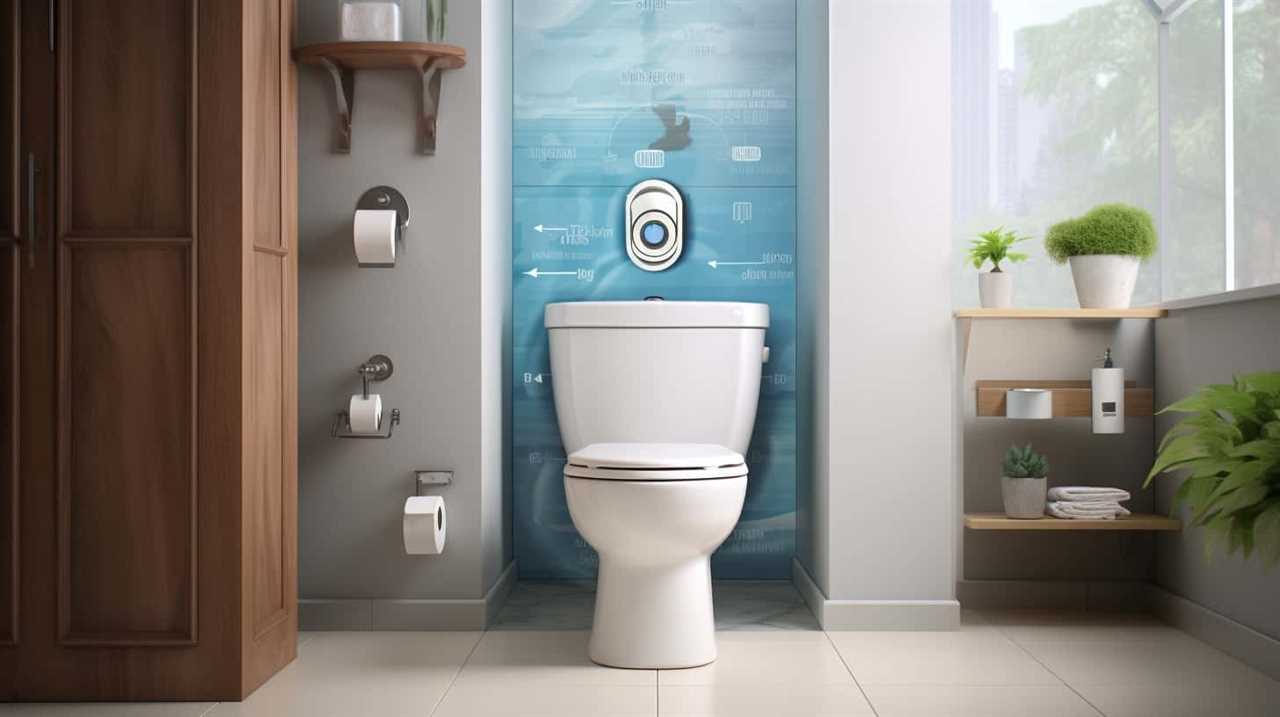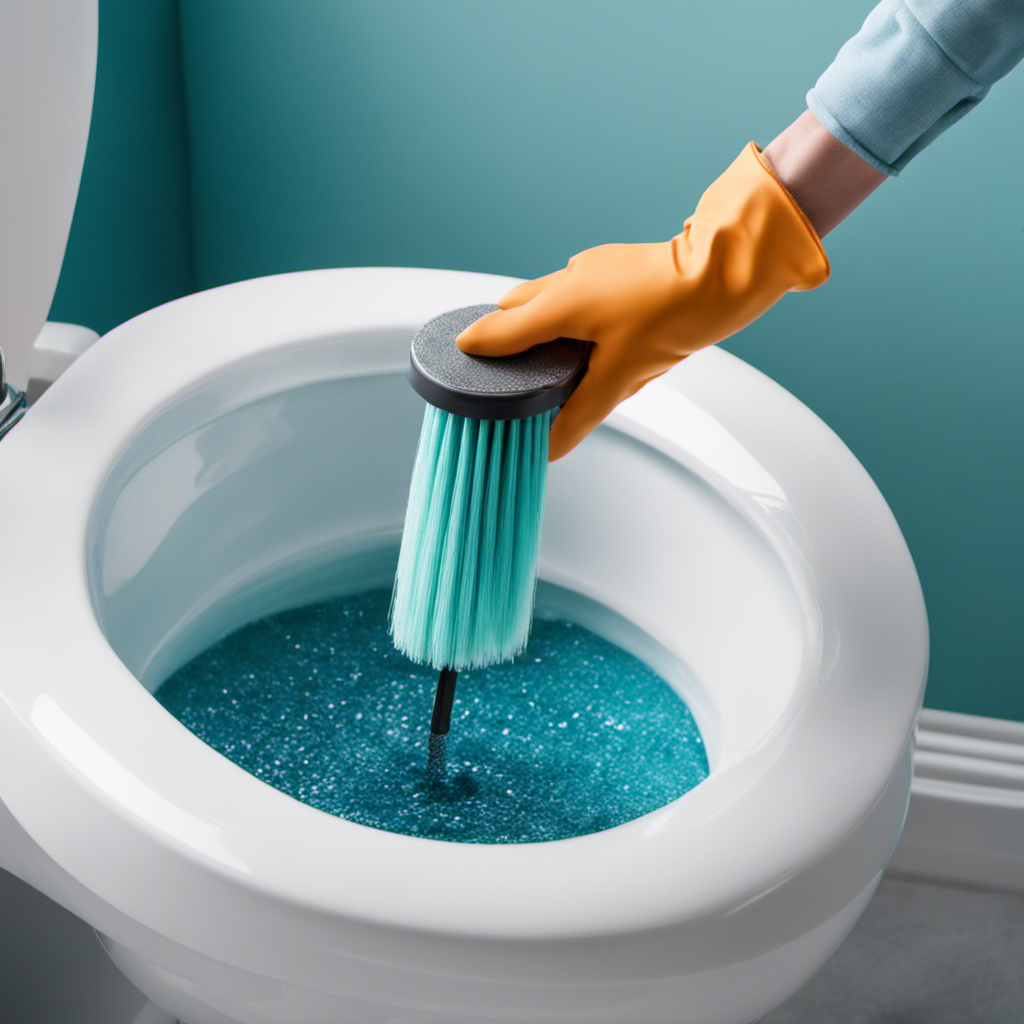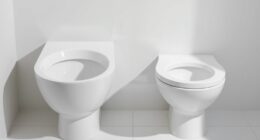As a homeowner, keeping a clean toilet tank is imperative for maintaining a healthy and odor-free bathroom.
In this article, I’ll guide you through the step-by-step process of cleaning your toilet tank, ensuring that it remains in pristine condition.
By following these simple instructions, you’ll be able to remove stubborn stains and prevent any future issues.
So, let’s roll up our sleeves and get ready to tackle this important task.
Key Takeaways
- Regular cleaning of the toilet tank prevents the buildup of bacteria, mold, and mildew.
- Cleaning the toilet tank helps to avoid unpleasant odors and potential health hazards.
- Regular cleaning improves the efficiency of the flushing system and ensures a more reliable and effective flush.
- Using safe cleaning methods and non-toxic cleaners is important to protect yourself and the environment.
Why Clean the Toilet Tank
Regular cleaning of the toilet tank is essential for maintaining proper sanitation and ensuring hygienic conditions in your bathroom.
The benefits of regular cleaning are numerous. Firstly, it helps to prevent the buildup of bacteria, mold, and mildew inside the tank, which can lead to unpleasant odors and potential health hazards.
Secondly, it helps to prolong the lifespan of the toilet by preventing mineral deposits and rust from forming on the internal components.
Additionally, regular cleaning of the tank can improve the overall efficiency of the flushing system, ensuring a more reliable and effective flush.
Safety Precautions for Cleaning the Toilet Tank
When handling this task, remember to wear gloves and ensure proper ventilation in the area. Cleaning the toilet tank can involve the use of toxic chemicals, so it’s crucial to prioritize safety.
Here are three important safety precautions to follow:
-
Wear gloves: Protect your hands from direct contact with the toxic chemicals by wearing gloves. This will help prevent skin irritation and potential chemical absorption.
-
Ensure proper ventilation: Toxic chemicals can release harmful fumes, so it’s essential to have proper ventilation in the area. Open windows and turn on fans to allow fresh air to circulate and minimize exposure to the fumes.
-
Read and follow instructions: Each cleaning product has specific instructions for safe use. Read and follow these instructions carefully, including any recommended safety precautions or protective gear.
Gathering the Necessary Supplies
To gather all the necessary supplies, make sure you have gloves, cleaning solution, and a scrub brush. These are essential cleaning products for effectively cleaning the toilet tank.
When it comes to toilet tank cleaning tools, a scrub brush with stiff bristles is ideal for scrubbing away any stubborn stains or buildup. It’s important to wear gloves to protect your hands from any potentially harmful bacteria or chemicals during the cleaning process.
Additionally, choosing the right cleaning solution is crucial for a thorough clean. Look for a toilet tank cleaner that is specifically designed to remove mineral deposits, bacteria, and odors.
Having these essential supplies on hand will ensure that you have everything you need to tackle the task of cleaning your toilet tank effectively.
Step-by-Step Guide to Cleaning the Toilet Tank
Start by gathering all the necessary supplies, making sure you have gloves, cleaning solution, and a scrub brush with stiff bristles.
To clean the toilet tank effectively, follow these step-by-step instructions:
-
Turn off the water supply: Locate the water shut-off valve behind the toilet and turn it clockwise to stop the flow of water into the tank.
-
Drain the tank: Flush the toilet to remove as much water as possible from the tank.
-
Clean the tank: Apply the recommended cleaning product to the inside walls of the tank, ensuring that you cover all surfaces. Use the scrub brush to scrub away any dirt or stains, paying close attention to corners and crevices.
Remember to rinse the tank thoroughly before turning the water supply back on.
Following these steps and using the recommended cleaning products will help you maintain a clean and hygienic toilet tank.
Removing Stubborn Stains From the Toilet Tank
When it comes to removing stubborn stains from the toilet tank, there are a few key points to consider.
First and foremost, it is important to use effective stain removal techniques that target the specific type of stain you are dealing with.
Additionally, taking preventative measures can help minimize future stains. This includes regularly cleaning the toilet tank and using products that help prevent the buildup of mineral deposits.
Lastly, it is crucial to prioritize safe cleaning methods. This involves using non-toxic cleaners and following proper safety precautions to protect yourself and the environment.
Effective Stain Removal
You’ll want to use a specialized toilet cleaner to effectively remove stubborn stains from the tank. Here are three important factors to consider when choosing an eco-friendly cleaner for stain prevention:
-
Biodegradability: Look for cleaners that are biodegradable and break down easily in the environment. This ensures that harmful chemicals are not released into the water supply.
-
Non-toxic formula: Opt for cleaners that are free from harsh chemicals like bleach and ammonia. These can be harmful to both your health and the environment.
-
Effectiveness: Choose a cleaner that is specifically formulated to remove stains from toilet tanks. Look for products that have proven track records in tackling tough stains, such as rust or hard water deposits.
Preventing Future Stains
To prevent future stains, make sure to regularly use an eco-friendly cleaner that is specifically designed to tackle tough stains in your toilet. This will not only help in reducing water stains but also prevent odor buildup. It is important to choose a cleaner that is safe for your toilet and the environment.
Look for products that are free of harsh chemicals and use natural ingredients. Additionally, consider using a toilet bowl cleaner that has antibacterial properties to ensure a clean and hygienic toilet. By incorporating regular cleaning into your routine, you can maintain a fresh and stain-free toilet.
Now that we have discussed preventing future stains, let’s move on to safe cleaning methods to ensure the longevity of your toilet.
Safe Cleaning Methods
If you’re concerned about the chemicals in traditional cleaning products, consider using natural alternatives that are effective and safe for your bathroom surfaces.
Here are three eco-friendly options for sanitizing your bathroom:
-
Vinegar: Mix equal parts white vinegar and water in a spray bottle. Spray the solution onto bathroom surfaces, such as the toilet tank, and let it sit for a few minutes. Then, scrub with a toilet brush and rinse with water. Vinegar is a natural disinfectant that can kill bacteria and viruses.
-
Baking soda: Sprinkle baking soda onto the toilet tank and scrub with a toilet brush. Baking soda is a gentle abrasive that can remove stains and odors without damaging the surface.
-
Tea tree oil: Add a few drops of tea tree oil to a spray bottle filled with water. Spray the solution onto the toilet tank and wipe with a cloth. Tea tree oil has antimicrobial properties that can help kill germs and prevent bacterial growth.
These natural sanitizing methods are not only effective but also safe for you and the environment.
Tips for Maintaining a Clean Toilet Tank
To maintain a clean toilet tank, it’s essential to focus on preventing bacterial growth and removing mineral deposits.
Bacterial growth can lead to unpleasant odors and potential health hazards, so regular cleaning and disinfection using appropriate cleaning agents is crucial.
Additionally, mineral deposits can build up over time and affect the performance of the toilet. To remove these deposits and keep the tank in optimal condition, using vinegar or commercial descaling agents can be helpful.
Preventing Bacterial Growth
Make sure you’re regularly cleaning the toilet tank to prevent bacteria from growing. Bacterial growth in the toilet tank can lead to foul odors and the formation of mold. Here are three essential tips to prevent bacterial growth and maintain a clean toilet tank:
-
Use a disinfectant cleaner: Regularly clean the interior of the toilet tank using a disinfectant cleaner. This will help kill any existing bacteria and prevent new bacteria from forming.
-
Inspect and clean the tank components: Check the tank components such as the flapper, fill valve, and overflow tube for any signs of mold or bacteria. Clean them thoroughly to eliminate any potential sources of bacterial growth.
-
Control moisture levels: Excessive moisture can promote bacterial growth. Make sure the toilet tank is properly sealed to prevent leaks and condensation. Additionally, consider using a dehumidifier in the bathroom to reduce humidity levels.
Removing Mineral Deposits
Regular cleaning with vinegar can help remove mineral deposits that may accumulate in the toilet tank. It is important to regularly clean the toilet tank to prevent the build-up of mineral deposits, which can affect the performance of the toilet and lead to clogs. To effectively remove these deposits, I recommend using natural cleaning solutions like vinegar. Vinegar is a powerful cleaner that can dissolve mineral deposits and remove rust stains.
Here is a table that illustrates the steps to remove mineral deposits using vinegar:
| Step | Description |
|---|---|
| 1 | Turn off the water supply to the toilet tank. |
| 2 | Flush the toilet to empty the tank. |
| 3 | Pour vinegar into the tank, covering the mineral deposits. |
| 4 | Let the vinegar sit for a few hours or overnight. |
| 5 | Scrub the tank with a brush to remove the loosened deposits. |
| 6 | Turn on the water supply and flush the toilet to rinse the tank. |
Troubleshooting Common Toilet Tank Cleaning Issues
If you’re having trouble cleaning your toilet tank, here are some common issues you may encounter:
-
Toilet Tank Leaks: One of the most common problems is a leaking toilet tank. This can be caused by a faulty fill valve or a crack in the tank. To fix this issue, you will need to replace the faulty parts or repair the crack. It’s important to address this problem promptly to prevent water waste and potential water damage.
-
Foul Odor: Another issue that may arise is a foul odor coming from the toilet tank. This can be caused by bacteria and mold growth due to stagnant water or an improperly sealed tank. To eliminate the odor, thoroughly clean the tank using a mixture of bleach and water and ensure proper ventilation in the bathroom.
-
Inefficient Flushing: If you notice that your toilet is not flushing properly, the problem may lie in the tank. Check the water level in the tank and adjust it if necessary. Additionally, clean the flush valve and flapper to ensure smooth and efficient flushing.
Conclusion
In conclusion, cleaning the toilet tank is an essential task for maintaining a hygienic bathroom environment. By following the step-by-step guide and using the necessary supplies, you can ensure that your toilet tank remains clean and free from bacteria.
Interestingly, a study conducted by the National Sanitation Foundation found that the toilet tank is one of the most germ-infested areas in the bathroom, with an average of 3.2 million bacteria per square inch. Therefore, regular cleaning and maintenance are crucial to ensure a healthy and clean toilet tank.










